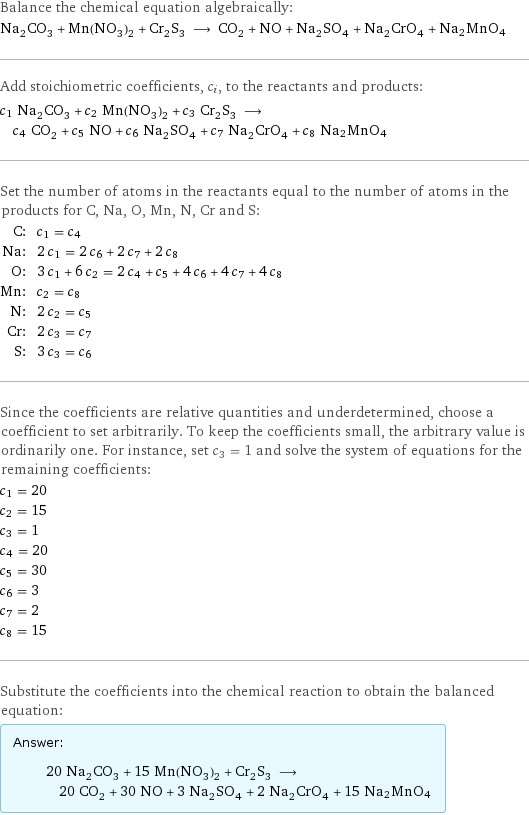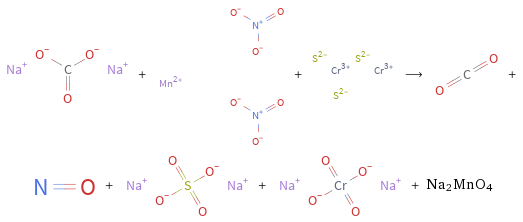Input interpretation

Na_2CO_3 soda ash + Mn(NO_3)_2 manganese(II) nitrate + Cr_2S_3 chromium(III) sulfide ⟶ CO_2 carbon dioxide + NO nitric oxide + Na_2SO_4 sodium sulfate + Na_2CrO_4 sodium chromate + Na2MnO4
Balanced equation

Balance the chemical equation algebraically: Na_2CO_3 + Mn(NO_3)_2 + Cr_2S_3 ⟶ CO_2 + NO + Na_2SO_4 + Na_2CrO_4 + Na2MnO4 Add stoichiometric coefficients, c_i, to the reactants and products: c_1 Na_2CO_3 + c_2 Mn(NO_3)_2 + c_3 Cr_2S_3 ⟶ c_4 CO_2 + c_5 NO + c_6 Na_2SO_4 + c_7 Na_2CrO_4 + c_8 Na2MnO4 Set the number of atoms in the reactants equal to the number of atoms in the products for C, Na, O, Mn, N, Cr and S: C: | c_1 = c_4 Na: | 2 c_1 = 2 c_6 + 2 c_7 + 2 c_8 O: | 3 c_1 + 6 c_2 = 2 c_4 + c_5 + 4 c_6 + 4 c_7 + 4 c_8 Mn: | c_2 = c_8 N: | 2 c_2 = c_5 Cr: | 2 c_3 = c_7 S: | 3 c_3 = c_6 Since the coefficients are relative quantities and underdetermined, choose a coefficient to set arbitrarily. To keep the coefficients small, the arbitrary value is ordinarily one. For instance, set c_3 = 1 and solve the system of equations for the remaining coefficients: c_1 = 20 c_2 = 15 c_3 = 1 c_4 = 20 c_5 = 30 c_6 = 3 c_7 = 2 c_8 = 15 Substitute the coefficients into the chemical reaction to obtain the balanced equation: Answer: | | 20 Na_2CO_3 + 15 Mn(NO_3)_2 + Cr_2S_3 ⟶ 20 CO_2 + 30 NO + 3 Na_2SO_4 + 2 Na_2CrO_4 + 15 Na2MnO4
Structures

+ + ⟶ + + + + Na2MnO4
Names

soda ash + manganese(II) nitrate + chromium(III) sulfide ⟶ carbon dioxide + nitric oxide + sodium sulfate + sodium chromate + Na2MnO4
Equilibrium constant
![Construct the equilibrium constant, K, expression for: Na_2CO_3 + Mn(NO_3)_2 + Cr_2S_3 ⟶ CO_2 + NO + Na_2SO_4 + Na_2CrO_4 + Na2MnO4 Plan: • Balance the chemical equation. • Determine the stoichiometric numbers. • Assemble the activity expression for each chemical species. • Use the activity expressions to build the equilibrium constant expression. Write the balanced chemical equation: 20 Na_2CO_3 + 15 Mn(NO_3)_2 + Cr_2S_3 ⟶ 20 CO_2 + 30 NO + 3 Na_2SO_4 + 2 Na_2CrO_4 + 15 Na2MnO4 Assign stoichiometric numbers, ν_i, using the stoichiometric coefficients, c_i, from the balanced chemical equation in the following manner: ν_i = -c_i for reactants and ν_i = c_i for products: chemical species | c_i | ν_i Na_2CO_3 | 20 | -20 Mn(NO_3)_2 | 15 | -15 Cr_2S_3 | 1 | -1 CO_2 | 20 | 20 NO | 30 | 30 Na_2SO_4 | 3 | 3 Na_2CrO_4 | 2 | 2 Na2MnO4 | 15 | 15 Assemble the activity expressions accounting for the state of matter and ν_i: chemical species | c_i | ν_i | activity expression Na_2CO_3 | 20 | -20 | ([Na2CO3])^(-20) Mn(NO_3)_2 | 15 | -15 | ([Mn(NO3)2])^(-15) Cr_2S_3 | 1 | -1 | ([Cr2S3])^(-1) CO_2 | 20 | 20 | ([CO2])^20 NO | 30 | 30 | ([NO])^30 Na_2SO_4 | 3 | 3 | ([Na2SO4])^3 Na_2CrO_4 | 2 | 2 | ([Na2CrO4])^2 Na2MnO4 | 15 | 15 | ([Na2MnO4])^15 The equilibrium constant symbol in the concentration basis is: K_c Mulitply the activity expressions to arrive at the K_c expression: Answer: | | K_c = ([Na2CO3])^(-20) ([Mn(NO3)2])^(-15) ([Cr2S3])^(-1) ([CO2])^20 ([NO])^30 ([Na2SO4])^3 ([Na2CrO4])^2 ([Na2MnO4])^15 = (([CO2])^20 ([NO])^30 ([Na2SO4])^3 ([Na2CrO4])^2 ([Na2MnO4])^15)/(([Na2CO3])^20 ([Mn(NO3)2])^15 [Cr2S3])](../image_source/e4c5dc43bf5fb736a6a339c0e19d6227.png)
Construct the equilibrium constant, K, expression for: Na_2CO_3 + Mn(NO_3)_2 + Cr_2S_3 ⟶ CO_2 + NO + Na_2SO_4 + Na_2CrO_4 + Na2MnO4 Plan: • Balance the chemical equation. • Determine the stoichiometric numbers. • Assemble the activity expression for each chemical species. • Use the activity expressions to build the equilibrium constant expression. Write the balanced chemical equation: 20 Na_2CO_3 + 15 Mn(NO_3)_2 + Cr_2S_3 ⟶ 20 CO_2 + 30 NO + 3 Na_2SO_4 + 2 Na_2CrO_4 + 15 Na2MnO4 Assign stoichiometric numbers, ν_i, using the stoichiometric coefficients, c_i, from the balanced chemical equation in the following manner: ν_i = -c_i for reactants and ν_i = c_i for products: chemical species | c_i | ν_i Na_2CO_3 | 20 | -20 Mn(NO_3)_2 | 15 | -15 Cr_2S_3 | 1 | -1 CO_2 | 20 | 20 NO | 30 | 30 Na_2SO_4 | 3 | 3 Na_2CrO_4 | 2 | 2 Na2MnO4 | 15 | 15 Assemble the activity expressions accounting for the state of matter and ν_i: chemical species | c_i | ν_i | activity expression Na_2CO_3 | 20 | -20 | ([Na2CO3])^(-20) Mn(NO_3)_2 | 15 | -15 | ([Mn(NO3)2])^(-15) Cr_2S_3 | 1 | -1 | ([Cr2S3])^(-1) CO_2 | 20 | 20 | ([CO2])^20 NO | 30 | 30 | ([NO])^30 Na_2SO_4 | 3 | 3 | ([Na2SO4])^3 Na_2CrO_4 | 2 | 2 | ([Na2CrO4])^2 Na2MnO4 | 15 | 15 | ([Na2MnO4])^15 The equilibrium constant symbol in the concentration basis is: K_c Mulitply the activity expressions to arrive at the K_c expression: Answer: | | K_c = ([Na2CO3])^(-20) ([Mn(NO3)2])^(-15) ([Cr2S3])^(-1) ([CO2])^20 ([NO])^30 ([Na2SO4])^3 ([Na2CrO4])^2 ([Na2MnO4])^15 = (([CO2])^20 ([NO])^30 ([Na2SO4])^3 ([Na2CrO4])^2 ([Na2MnO4])^15)/(([Na2CO3])^20 ([Mn(NO3)2])^15 [Cr2S3])
Rate of reaction
![Construct the rate of reaction expression for: Na_2CO_3 + Mn(NO_3)_2 + Cr_2S_3 ⟶ CO_2 + NO + Na_2SO_4 + Na_2CrO_4 + Na2MnO4 Plan: • Balance the chemical equation. • Determine the stoichiometric numbers. • Assemble the rate term for each chemical species. • Write the rate of reaction expression. Write the balanced chemical equation: 20 Na_2CO_3 + 15 Mn(NO_3)_2 + Cr_2S_3 ⟶ 20 CO_2 + 30 NO + 3 Na_2SO_4 + 2 Na_2CrO_4 + 15 Na2MnO4 Assign stoichiometric numbers, ν_i, using the stoichiometric coefficients, c_i, from the balanced chemical equation in the following manner: ν_i = -c_i for reactants and ν_i = c_i for products: chemical species | c_i | ν_i Na_2CO_3 | 20 | -20 Mn(NO_3)_2 | 15 | -15 Cr_2S_3 | 1 | -1 CO_2 | 20 | 20 NO | 30 | 30 Na_2SO_4 | 3 | 3 Na_2CrO_4 | 2 | 2 Na2MnO4 | 15 | 15 The rate term for each chemical species, B_i, is 1/ν_i(Δ[B_i])/(Δt) where [B_i] is the amount concentration and t is time: chemical species | c_i | ν_i | rate term Na_2CO_3 | 20 | -20 | -1/20 (Δ[Na2CO3])/(Δt) Mn(NO_3)_2 | 15 | -15 | -1/15 (Δ[Mn(NO3)2])/(Δt) Cr_2S_3 | 1 | -1 | -(Δ[Cr2S3])/(Δt) CO_2 | 20 | 20 | 1/20 (Δ[CO2])/(Δt) NO | 30 | 30 | 1/30 (Δ[NO])/(Δt) Na_2SO_4 | 3 | 3 | 1/3 (Δ[Na2SO4])/(Δt) Na_2CrO_4 | 2 | 2 | 1/2 (Δ[Na2CrO4])/(Δt) Na2MnO4 | 15 | 15 | 1/15 (Δ[Na2MnO4])/(Δt) (for infinitesimal rate of change, replace Δ with d) Set the rate terms equal to each other to arrive at the rate expression: Answer: | | rate = -1/20 (Δ[Na2CO3])/(Δt) = -1/15 (Δ[Mn(NO3)2])/(Δt) = -(Δ[Cr2S3])/(Δt) = 1/20 (Δ[CO2])/(Δt) = 1/30 (Δ[NO])/(Δt) = 1/3 (Δ[Na2SO4])/(Δt) = 1/2 (Δ[Na2CrO4])/(Δt) = 1/15 (Δ[Na2MnO4])/(Δt) (assuming constant volume and no accumulation of intermediates or side products)](../image_source/14b2f3ce9684f531aaba9eacb05a97ff.png)
Construct the rate of reaction expression for: Na_2CO_3 + Mn(NO_3)_2 + Cr_2S_3 ⟶ CO_2 + NO + Na_2SO_4 + Na_2CrO_4 + Na2MnO4 Plan: • Balance the chemical equation. • Determine the stoichiometric numbers. • Assemble the rate term for each chemical species. • Write the rate of reaction expression. Write the balanced chemical equation: 20 Na_2CO_3 + 15 Mn(NO_3)_2 + Cr_2S_3 ⟶ 20 CO_2 + 30 NO + 3 Na_2SO_4 + 2 Na_2CrO_4 + 15 Na2MnO4 Assign stoichiometric numbers, ν_i, using the stoichiometric coefficients, c_i, from the balanced chemical equation in the following manner: ν_i = -c_i for reactants and ν_i = c_i for products: chemical species | c_i | ν_i Na_2CO_3 | 20 | -20 Mn(NO_3)_2 | 15 | -15 Cr_2S_3 | 1 | -1 CO_2 | 20 | 20 NO | 30 | 30 Na_2SO_4 | 3 | 3 Na_2CrO_4 | 2 | 2 Na2MnO4 | 15 | 15 The rate term for each chemical species, B_i, is 1/ν_i(Δ[B_i])/(Δt) where [B_i] is the amount concentration and t is time: chemical species | c_i | ν_i | rate term Na_2CO_3 | 20 | -20 | -1/20 (Δ[Na2CO3])/(Δt) Mn(NO_3)_2 | 15 | -15 | -1/15 (Δ[Mn(NO3)2])/(Δt) Cr_2S_3 | 1 | -1 | -(Δ[Cr2S3])/(Δt) CO_2 | 20 | 20 | 1/20 (Δ[CO2])/(Δt) NO | 30 | 30 | 1/30 (Δ[NO])/(Δt) Na_2SO_4 | 3 | 3 | 1/3 (Δ[Na2SO4])/(Δt) Na_2CrO_4 | 2 | 2 | 1/2 (Δ[Na2CrO4])/(Δt) Na2MnO4 | 15 | 15 | 1/15 (Δ[Na2MnO4])/(Δt) (for infinitesimal rate of change, replace Δ with d) Set the rate terms equal to each other to arrive at the rate expression: Answer: | | rate = -1/20 (Δ[Na2CO3])/(Δt) = -1/15 (Δ[Mn(NO3)2])/(Δt) = -(Δ[Cr2S3])/(Δt) = 1/20 (Δ[CO2])/(Δt) = 1/30 (Δ[NO])/(Δt) = 1/3 (Δ[Na2SO4])/(Δt) = 1/2 (Δ[Na2CrO4])/(Δt) = 1/15 (Δ[Na2MnO4])/(Δt) (assuming constant volume and no accumulation of intermediates or side products)
Chemical names and formulas

| soda ash | manganese(II) nitrate | chromium(III) sulfide | carbon dioxide | nitric oxide | sodium sulfate | sodium chromate | Na2MnO4 formula | Na_2CO_3 | Mn(NO_3)_2 | Cr_2S_3 | CO_2 | NO | Na_2SO_4 | Na_2CrO_4 | Na2MnO4 Hill formula | CNa_2O_3 | MnN_2O_6 | Cr_2S_3 | CO_2 | NO | Na_2O_4S | CrNa_2O_4 | MnNa2O4 name | soda ash | manganese(II) nitrate | chromium(III) sulfide | carbon dioxide | nitric oxide | sodium sulfate | sodium chromate | IUPAC name | disodium carbonate | manganese(2+) dinitrate | chromium(+3) cation trisulfide | carbon dioxide | nitric oxide | disodium sulfate | disodium dioxido(dioxo)chromium |